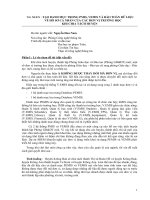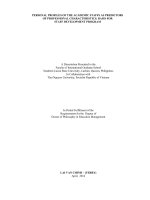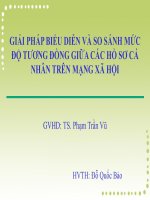hồ sơ cá nhân
Bạn đang xem bản rút gọn của tài liệu. Xem và tải ngay bản đầy đủ của tài liệu tại đây (472.89 KB, 10 trang )
THE 28
TH
CONFERENCE OF THE FEDERATION OF ENGINEERING
ORGANIZATIONS
CAFEO 28 HANOI VIETNAM, 30
TH
NOV. - 2
ND
DEC., 2010
TITLE:
COD AND COLOUR REMOVAL OF SECURE
LANDFILL LEACHATE BY FERRIC CHLORIDE,
ZEOLITE AND HYDROGEN PEROXIDE.
YOUR PHOTO
(or you can attach a
separate file for
photo)
AUTHOR(S)’
NAME(S):
Warunthorn Kumpila*
Associate Professor, Doctor
Thares
Srisatit**
ORGANIZATION
&
DESIGNATION:
Department of Environmental Engineering,
Chulalongkorn University, Bangkok Thailand
ADDRESS:
487 Moo 13 Sub District Kudkao District Munjakiri*
Province Khonkean 40160*
Department of Environmental Engineering**
Chulalongkorn University, Bangkok Thailand**
TEL:
087-3833946* 02-2186679**
FAX:
02-2186666
EMAIL: *, **
Warunthorn Kumpila
COD AND COLOUR REMOVAL OF SECURE LANDFILL LEACHATE
BY FERRIC CHLORIDE, ZEOLITE AND HYDROGEN PEROXIDE.
Warunthorn Kumpila* and Thares Srisatit**
Department of Environmental Engineering, Chulalongkorn University, Bangkok Thailand
Email:
*, **
ABSTRACT
Secure landfill leachate is always a high-strength wastewater characterized by
extremes of pH, chemical oxygen demand (COD), biochemical oxygen demand (BOD),
inorganic salts and toxicity. At the same time, its composition is variable over the time and
space at a particular landfill. It contains a mixture of many chemical compounds originated
from the various disposed materials or they may also result from biotic and abiotic processes
in the system. The composition of the leached wastewater is based on the composition and
the degree of contouring and compacting of solid wastes, physicochemical conditions at the
landfill, geology and landfill age. This research was studies the ability of using ferric
chloride, zeolite and hydrogen peroxide for COD and color removal from leachate of the
secure landfill in Thailand. In this research, divides to are four experiment, the first study
the character at the beginning of the leachate, for example pH, COD, BOD, TDS, TSS,
Heavy Metal, colour. The second study the ability of using ferric chloride for COD removal
by jar test. The third batch test by zeolite. The forth oxidation process with Fe
2+
/H
2
O
2
. The
results found that the concentration of ferric chloride 300 mg/l at pH 3 can reduce 50% of
COD then continuous process that filtrated by 10 g/l of leachate of zeolite at pH 5, contact
time 180 min, can reduce 30% of COD when the process oxidized by Fe
2+
/H
2
O
2
can reduce
20% and 30% of COD and color respectively. Totally this process cans removal 70-80% of
COD. The aim of research is the practical method, easy operate more over low cost as the
results can be accepted when compare with the standard value.
Introduction
Secure landfill leachate is always a high-strength wastewater characterized by
extremes of pH, chemical oxygen demand (COD), biochemical oxygen demand (BOD),
inorganic salts and toxicity. At the same time, its composition is variable over the time and
space at a particular landfill. It contains a mixture of many chemical compounds originated
from the various disposed materials and/or they may also result from biotic and a biotic
process in the system. The composition of the leached wastewater is based on the
composition and the degree of contouring and compacting of solid wastes, physicochemical
conditions at the landfill, local rainfall regime that regulates moisture level, geology and
landfill age (Zgajnar, Tisler and Zagorc-Kon, 2009). Present compounds could constitute a
potential risk to the quality of receiving water bodies, when leachates are released into the
environment, because they are usually toxic, resistant to environmental degradation and have
other characteristics which makes them hazardous to the environment. The understanding,
monitoring and management of quantity and quality of landfill leachate during operation and
after secure landfill closure are of a great importance. Careful site management can reduce
the quality and pollution potential of the formed leachate, but it cannot completely eliminate
it. These substances should be caught and treated properly, to avoid contamination of
receiving environment. Treatment methods must be matched to the actual characteristics of
the particular leachate.
For many years, conventional biological treatments and classical physicochemical
methods were considered the most appropriate technologies for manipulation and
management of high-strength effluents like landfill leachate. Various techniques, such as
sequencing batch reactor (SBR) and its modification, upflow anaerobic sludge blanket
(UASB), coagulation–flocculation, adsorption, air stripping, and so on, have been used to
treat secure landfill leachate. Physicochemical treatments can then act as a refining step for
the stabilized effluent of biologically treated leachate.
The purpose of this research was studies the ability of using ferric chloride, zeolite
and hydrogen peroxide for COD and color removal from secure landfill leachate. In this
research, divides to are four experiment, the first study the character at the beginning of the
leachate, for example pH, COD, BOD, TDS, TSS, Heavy Metal, color. The second study the
ability of using ferric chloride for COD removal by jar test. The third batch test by zeolite.
The forth oxidation process with Fe
2+
/H
2
O
2
.
Material and methods
1. Characterization of secure landfill leachate
Secure landfill leachate originated from a landfill, where various wastes from several
production phases of the industrial factory and is located in Mabtaphud Industry is show in
Fig. 1. Secure Landfill used for hazardous waste that has been stabilized process and has
been made into solid. The secure site has been prepared with the technology used for
hazardous waste, which effectively prevents the water or pollutant from escape into the
environment. Compacted until the water seepage rate in 1x10
-7
cm/s and then lined with 8
layers of materials with leachate collection properly. After the wastes have filled up, it is
covered by soil and it has a system for separate collection of rain water. It has been in
operation for the past 10 years. Leachate is collected by drainage pipes into the basin. The
average daily leachate collected is between 20 and 30 m
3
, and it is treated by combustion in
cement kiln. It is cost of combustion 100-133 dollar/ m
3
.
The raw leachate was collected several times all year around from the reservoir, where all
entrapped leachate is collected (Zgajnar, Tisler and Zagorc-Kon, 2009). It has been stored in
a room temperature prior to experiments. The Fig. 2 show secure landfill leachate compare
with water supply. Analyses of raw leachate and monitoring of the treatment procedures
included pH, BOD, COD, TDS (Total Suspended Solid), TDS (Total dissolves Solid) Heavy
metal (Pb, Hg, As, Cr, Cd) are show in Table 1.
2. Coagulation and flocculation
Coagulation–flocculation experiments were performed with jar test equipment (FC 6S,
VELP scientific) comprising six paddle rotors equipped with six beakers of 1 L each 500 mL
of the leachate sample were put in each of the beakers, pH has been measured (SevenEasy,
Mettler Toledo) and mixing speed was set up at 120 rpm. Some experiments were also
conducted at lower pH which were attained by addition of 1M HCl p.a. prior to additions of
coagulant and flocculants (Hamidi et al., 2007; Huo et al., 2009; Zong et al., 2002; Zhen et
al., 2009). The different amounts of the coagulants FeCl
3
(from 100mg L
−1
to 1000mg L
−1
).
The final gravity settling stage lasted for another 2 h before sampling for COD analysis.
Fig. 1 Study Area.
Fig. 2 Characteristic of leachate
Mabtaphud
Industry
Clean water Landfill leachate
Table 1
Analysis parameter
3. Batch test by zeolite
Batch experiments were conducted at ambient temperature using the optimum conditions
of all pertinent factors, such as dose, pH, agitation speed, and contact time. Subsequent
adsorption experiments were carried out with only optimized parameters. The optimum
conditions for the adsorption batch study taken from the previous study are dose 0.01-10 mg,
pH 4-7, 200 rpm of shaking speed and 5-1440 min of contact time in 250 ml flasks containing
100 ml of the leachate sampler (Foo and Hameed, 2009). Adsorption isotherm tests were also
carried out in the reaction mixture consisting of 100 ml of leachate solution with varying
adsorbent weight. COD and color was determined using closed reflux colorimetric method
and spectrophotometric method respectively.
4. Oxidation process with Fe
2+
/H
2
O
2
Pre-experiment analysis concentrate of hydrogen peroxide was determined using
permanganate titration. Then determination of hydrogen peroxide initial concentration.
Added different amounts of the H
2
O
2
from 10 g L
−1
to 200 g L
−1
in 150 ml flasks containing
50 ml of the leachate sample and stirrer 1 h. The final gravity settling stage lasted for another
24 h before sampling for COD, color and iodometric titration analysis. Subsequent find the
appropriate pH conditions. Added different pH 3-12 in 150 ml flasks containing 50 ml of the
leachate sample and stirrer 1 h. The final gravity settling stage lasted for another 24 h before
sampling for COD, color and iodometric titration analysis. This experiment were also
conducted pH which were attained by addition of H
2
SO
4
and NaOH. Then determination of
the concentration of hydrogen peroxide appropriate. The optimum of the H
2
O
2
from previous
experiment in 150 ml flasks containing 50 ml of the leachate sampler and stirrer 1 h. The
final gravity settling stage lasted for another 24 h before sampling for COD, color and
iodometric titration analysis. The last experiment were study ferrous catalyst of coagulation
with oxidation by hydrogen peroxide (Mohan and Gandhimathi, 2009; Yanyu et al., 2010).
The optimum amounts of the H
2
O
2
and pH from previous experiment and add different
ferrous sulfate in 150 ml flasks containing 50 ml of the leachate sample and stirrer 1 h. The
final gravity settling stage lasted for another 24 h before sampling for COD, color and
iodometric titration analysis (Eyup, 2009; Hui, Heung and Chin-Pao, 2009).
Parameter unit Analytical Method
1. pH
2. COD
3. COLOR
4. BOD
5. TSS
6. TDS
7. HEAVY METAL (Pb, Hg, As, Cr,
Cd)
8. CONCENTRATION OF H
2
O
2
mg/l
pt.co
mg/l
mg/l
mg/l
mg/l
mg/l
pH meter
Closed reflux colorimetric method
Spectrophotometric method
Dilution method
Gravimetric, 103-105° C
Gravimetric, 103-105° C
Atomic Absorption Spectrophotometry
Permanganate titration and Iodometric
titration









